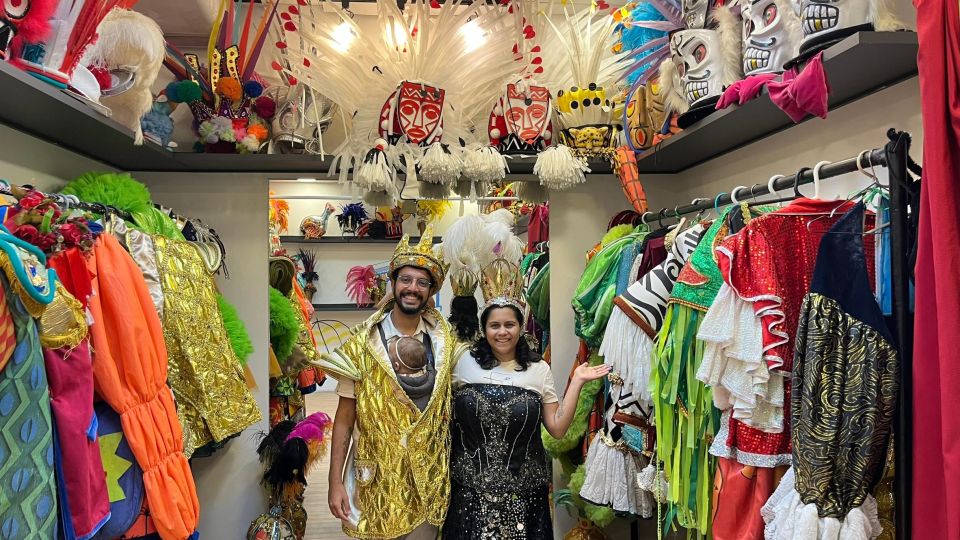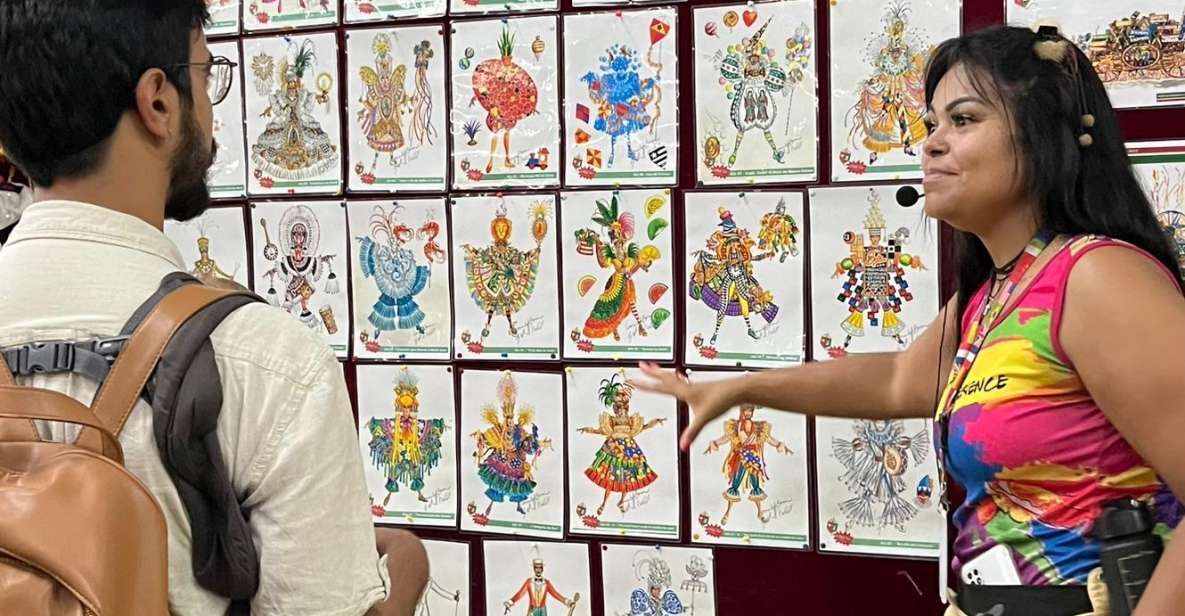In the bustling streets of Rio de Janeiro’s Little Africa neighborhood, the rhythmic beats of Samba echo through the air like a heartbeat, pulsating with the vibrant history of Afro-Brazilian culture.
As travelers navigate the colorful alleyways and enjoy the essence of Carnival, they uncover a world where traditions intertwine, creating a tapestry of dance, music, and celebration.
But what lies beneath the surface of this lively spectacle? Unravel the layers of Samba and Carnival’s origin, evolution, and influence as they intertwine with the heart of Brazil’s cultural identity.
Good To Know

- Samba and Carnival symbolize Brazil’s rich cultural heritage and history.
- African influences deeply embedded in Brazil’s Carnival traditions.
- Little Africa neighborhood bridges African-Brazilian heritage with Carnival celebrations.
- Carnival costumes embody pride, unity, and diverse cultural elements.
Historical Roots of Samba
Samba, a rhythmic and vibrant music genre, has deep historical roots in the rich cultural tapestry of Brazil. Originating from a fusion of various musical traditions, Samba embodies the diverse cultural influences that have shaped Brazil’s identity.
The dance styles associated with Samba are as diverse as the rhythmic influences that drive its beats. From the African rhythms brought by enslaved peoples to the European melodies of the colonial period, Samba encapsulates a history of cultural exchange and artistic expression.
This musical genre not only reflects the country’s past but also serves as a testament to the resilience and creativity of the Brazilian people. Samba’s evolution has been intertwined with Brazil’s history, making it a symbol of national pride and cultural heritage.
Influence of African Culture

With a rich tapestry of rhythms and traditions, the influence of African culture permeates deeply into the vibrant essence of Brazil’s musical and artistic heritage. This influence is evident in various aspects, shaping the country’s cultural landscape:
Cultural Traditions: African cultural traditions, such as dance, food, and religious practices, have blended with Brazilian customs, creating a unique fusion that’s celebrated during Carnival and other festivities.
Music Influences: African rhythms, beats, and instruments have significantly shaped Brazilian music, particularly Samba, which originated from African musical styles brought by enslaved Africans to Brazil.
Artistic Expressions: African art forms, motifs, and techniques have influenced Brazilian artists, inspiring colorful costumes, elaborate floats, and intricate designs seen during Carnival celebrations.
Evolution of Carnival Celebrations
The evolution of Carnival celebrations in Brazil showcases a dynamic fusion of cultural influences and historical traditions that have shaped this iconic festival over the centuries. Cultural evolution has played a significant role in shaping the music traditions, dance styles, and the overall festive atmosphere of Carnival. As Carnival evolved over time, it absorbed elements from various cultures, including indigenous, European, and African influences, creating a rich tapestry of traditions. The table below highlights some key aspects of the evolution of Carnival celebrations in Brazil:
| Aspect | Description | Impact |
|---|---|---|
| Cultural Evolution | Blend of indigenous, European, and African influences | Diverse and vibrant Carnival traditions |
| Music Traditions | Samba music becoming synonymous with Carnival celebrations | Rhythmic beats that drive the festive atmosphere |
| Festive Atmosphere | Colorful costumes, elaborate floats, and lively street parties | Creates a joyous and celebratory ambiance |
| Dance Styles | Various dance styles like samba, frevo, and maracatu gaining popularity among Carnival participants | Adds energy and dynamism to the Carnival celebrations |
Role of Little Africa Neighborhood
Nestled in the vibrant city of Rio de Janeiro, the Little Africa neighborhood plays a pivotal role in preserving and showcasing the rich African cultural heritage that influences Brazil’s Carnival traditions.
Cultural Diversity: Little Africa is a cultural melting pot where African traditions, music, and dance blend with Brazilian influences, creating a unique and vibrant atmosphere.
Neighborhood Dynamics: The community in Little Africa actively participates in Carnival preparations, with residents and local groups contributing to the authenticity and energy of the festivities.
Historical Significance: Little Africa serves as a living testament to the historical ties between Africa and Brazil, offering insights into the roots of Carnival and the enduring impact of African heritage on Brazilian society.
Impact on Brazilian Society
Preserving the vibrant African cultural heritage in Brazil, the Little Africa neighborhood in Rio de Janeiro has significantly influenced and shaped various aspects of Brazilian society, particularly the renowned Carnival traditions. The neighborhood’s impact on Brazilian society can be seen through social integration and cultural exchange, fostering a sense of unity among diverse communities. Plus, community empowerment is evident as residents come together to celebrate their heritage, promoting a sense of belonging and pride. Through artistic expression in music, dance, and costume design, the Little Africa neighborhood showcases the rich cultural tapestry of Brazil, influencing and inspiring creativity across the country.
| Impact on Brazilian Society | |
|---|---|
| Social Integration | Cultural Exchange |
| Community Empowerment | Artistic Expression |
Significance of Carnival Costumes
Amidst the vibrant streets of Rio de Janeiro’s Little Africa neighborhood, what cultural significance do the dazzling Carnival costumes hold for both participants and spectators alike? Carnival costumes play a pivotal role in the celebration, representing a fusion of history, culture, and creativity.
Evolutionary Trends: Over the years, Carnival costumes have evolved to reflect current trends and societal influences, showcasing a mix of traditional and modern elements.
Costume Design Innovations: Designers continuously push boundaries, incorporating new materials, technologies, and techniques to create elaborate and eye-catching costumes.
Symbolism and Identity: The costumes not only serve as visual spectacles but also carry deep symbolic meanings, often portraying narratives of heritage, pride, and unity within the community.
These elements combine to make the Carnival costumes a vibrant and integral part of the cultural fabric of Rio’s Carnival celebrations.
Preservation of Cultural Heritage
The preservation of cultural heritage in Rio de Janeiro’s Carnival festivities plays a crucial role in safeguarding and promoting the city’s rich history and traditions. Cultural preservation ensures that the vibrant essence of Rio’s Carnival, deeply rooted in African traditions, is passed down through generations.
Through community engagement, locals actively participate in heritage conservation, fostering a sense of belonging and cultural identity. The colorful costumes, rhythmic music, and spirited dances all reflect a tapestry of history and culture that must be protected.
Common Questions
Can Participants Try on Traditional Carnival Costumes During the Tour?
Participants can indulge in culture and unique experiences during the tour by trying on traditional carnival costumes. Costume fittings offer a hands-on exploration of the vibrant attire, adding an interactive element to the exploration.
Are There Any Specific Rituals or Ceremonies Related to African Religion That Visitors Can Witness in the Little Africa Neighborhood?
In the little Africa neighborhood, visitors can witness fascinating African rituals and cultural ceremonies. These experiences offer a unique insight into the rich traditions and practices of African religion in Brazil, providing a deeper understanding of the local culture.
How Are the Floats and Costumes for the Carnival Created and Designed?
Float design and costume creation for the carnival involve intricate planning and skilled artisans. Designers craft elaborate floats with vibrant colors, feathers, and intricate details. Costumes are meticulously sewn with sequins, beads, and fabrics to reflect the festive and cultural spirit.
Are There Any Hands-On Activities or Workshops Included in the Tour That Allow Participants to Learn More About the History and Culture of Samba?
Samba workshops and cultural activities on the tour provide hands-on learning experiences for participants to immerse in the history of samba. Engage in interactive sessions to deepen your understanding of this vibrant Brazilian dance form.
Are There Any Local Restaurants or Eateries in the Little Africa Neighborhood That Are Recommended for Trying Authentic Brazilian Cuisine?
In Rio’s Little Africa neighborhood, visitors can savor authentic Brazilian cuisine at local eateries. From delicious local flavors to traditional Brazilian dishes, these culinary experiences offer a true taste of the region’s rich gastronomic heritage.
The Sum Up
To sum it up, the little Africa neighborhood in Rio de Janeiro offers a fascinating glimpse into the history and culture of Samba and Carnival. With its rich African roots, vibrant costumes, and lively celebrations, this immersive tour provides a unique opportunity to experience the heartbeat of Brazilian culture.
From the pulsating rhythms of Afro-Brazilian music to the elaborate floats of Carnival, visitors are sure to be captivated by the energy and magic of this iconic cultural experience.
You can check if your dates are available here: